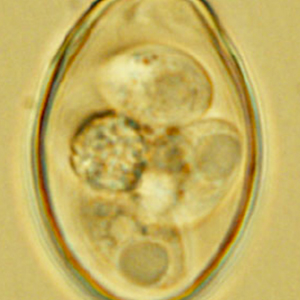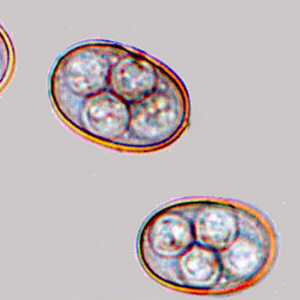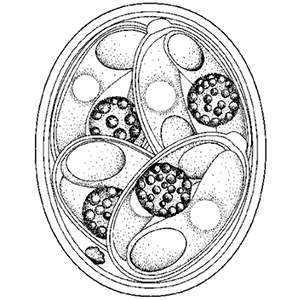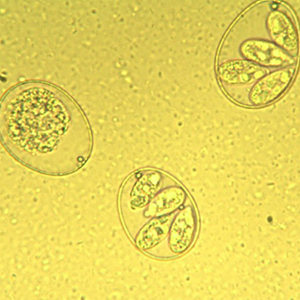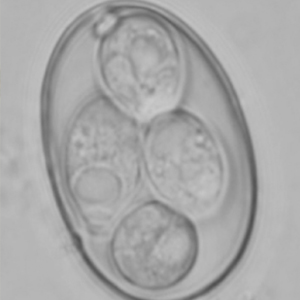Eimeria is a genus of coccidial protozoa found in many mammal and bird species, most of which are host specific. Nine species are reported to affect non-human primates: Eimeria galago, E. lemuris, E. otolicni, E. coucangi, E. nycticebi, E. pachylepyron, E. tarsi, Eimeria syrichta and E. boholensis (Dusznski et al., 1999; Hofmannováa et al., 2018).
Epidemiology
These coccidial parasites only affect prosimians, namely:
- The Senegal bushbay (Galago senegalensis) has been reported to be affected by Eimeria galago, E. lemuris and otolicni (Duszynski et al., 1999);
- The Sunda slow loris (Nycticebus coucang) has been reported to be affected by Eimeria coucangi, E. nycticebi and pachylepyron (Duszynski et al., 1999);
- The Philippine tarsier (Tarsius syrichta) has been reported to be affected by Eimeria tarsi, E. syrichta and boholensis (Duszynski et al., 1999; Hofmannováa et al., 2018).
Description
Oocysts are quite large (more than 10 to 13 µm in diameter) and refringent. They do not stain with Lugol, so a modified Ziehl-Neelsen stain is often preferred. They can be sporulated or non-sporulated:
- Non-sporulated oocysts present a granulomatous content and its internal structures are indistinguishable; in this form, it is impossible to differentiate Eimeria oocysts from Isospora oocysts;
- Sporulated oocysts contain 4 sporocysts with 2 sporozoites each (Duszynski et al., 1999; Hofmannováa et al., 2018).
Different species of Eimeria cannot be differentiated by coproscopic examination only.
Differential diagnosis
It mainly includes coccidial parasites from the genera Cyclospora and Isospora. However:
- Cyclospora are smaller in size (8 to 10 µm) and have sporulated oocysts containing 2 sporocysts with 2 sporozoites each. Moreover, they seem to mainly affect Old-World Monkeys and Apes. Fluorescence microscopy and differential interference contrast microscopy can be used to reach final diagnosis (Colomina Rodriguez & Villar Serrano, 1997).
- Although Isospora oocysts are of the same size as Eimeria oocysts, they contain 2 sporocysts with 4 sporozoites each. Moreover, Isospora do not typically affect prosimians (Duszynksli et al., 1999).
Sporulation is sometimes necessary to differentiate two types of coccidial parasite species. It is possible to induce sporulation by coproculture.
Clinical significance
Clinical signs like diarrhea may appear in immunosuppressed or young animals.
Prophylaxis and treatment
Little is known about anti-coccidial treatment in non-human primates. Trimethoprim-sulfamethoxazole and toltrazuril are normally the treatment of choice (Murphy, 2015; Williams, 2015).
Implementation of hygienic measures is also important for a proper management of the disease.
